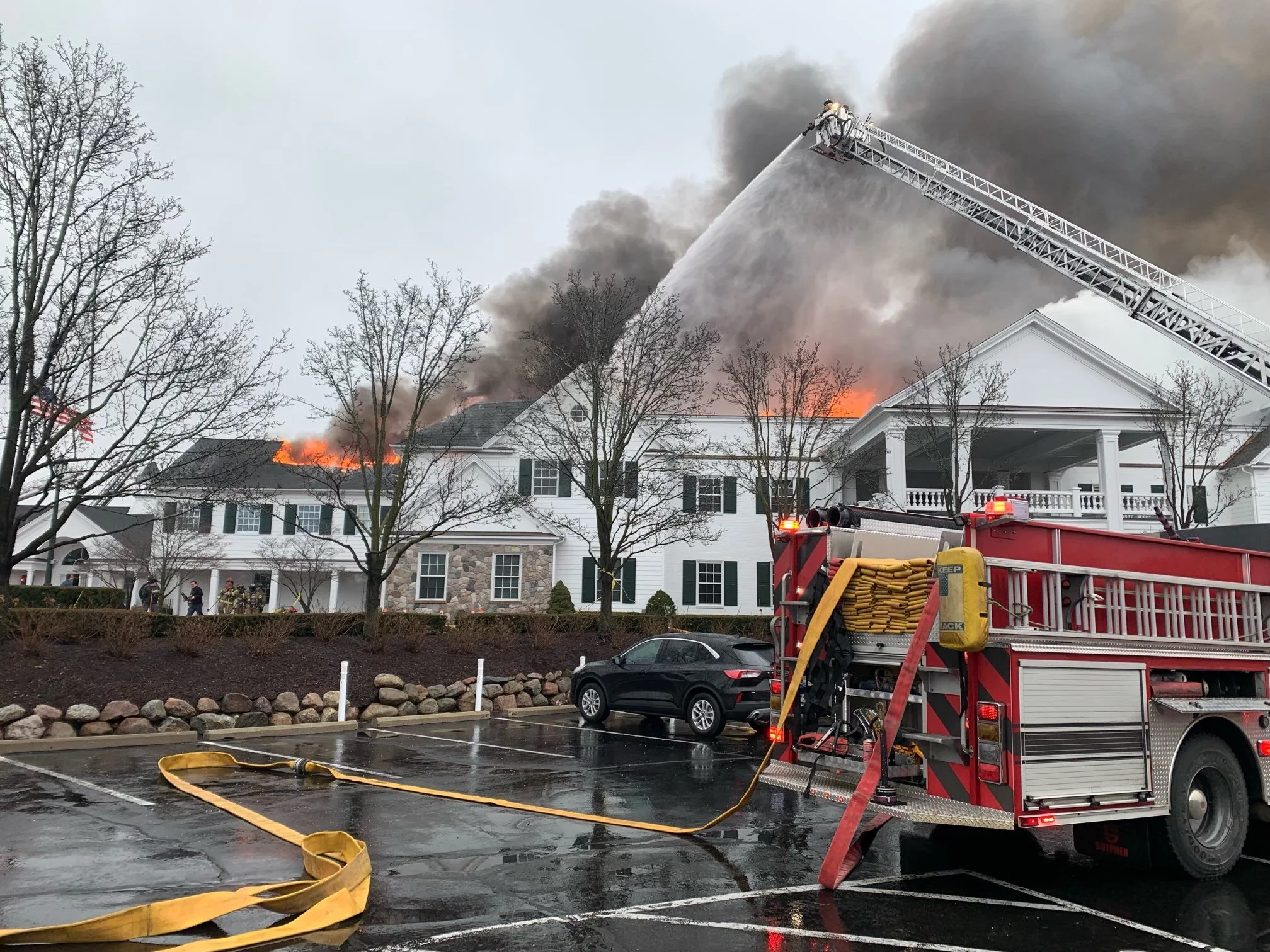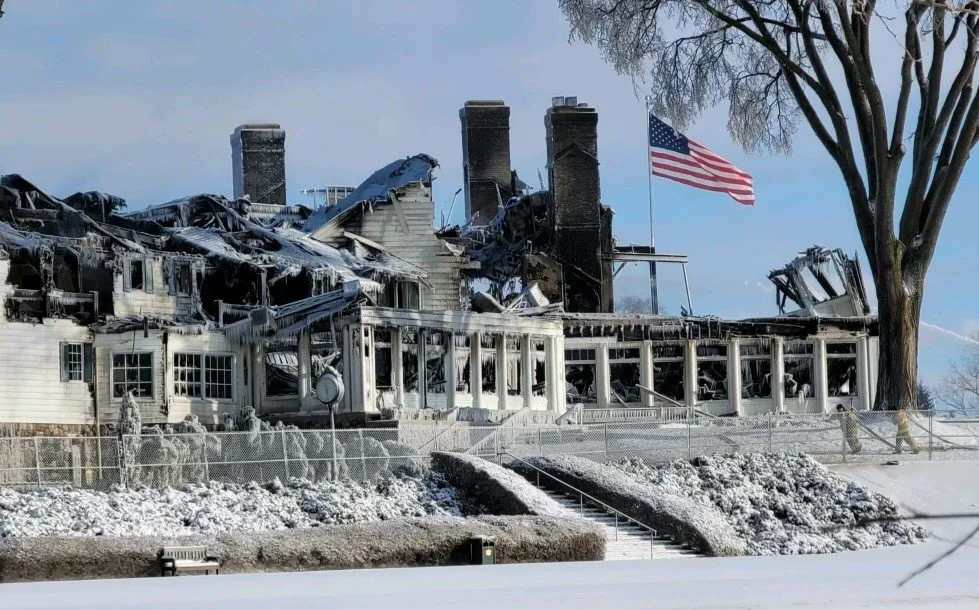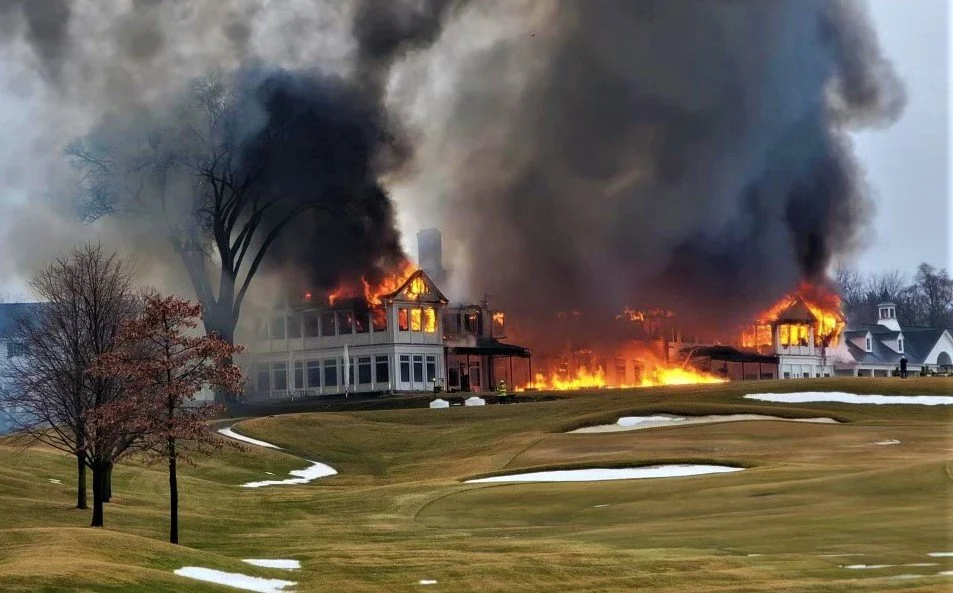Behind the Scenes: Diary of a Massive Fire
Salute to first responders of Feb. 17
By Janina Jacobs
Firefighters across America report for duty daily between 7-8 a.m. hoping for an uneventful day, but always preparing for the worst. Completing a lengthy safety checklist is first; coffee can wait. From assembling personal equipment and gear, to accounting for medical supplies, air tanks and forcible entry tools, they must also confirm that the fire trucks’ ladders, hoses, and tires are in working order as well as water tanks, oil and fuel levels are fully topped off. Everything must be ready to go at a moment’s notice.
In Michigan’s Oakland County, that moment came on February 17, 2022. Sounding more like a tee time, at 9:17am the first call rang in to Bloomfield Township Fire Department when kitchen staff at the legendary Oakland Hills Country Club smelled the odor of smoke and noticed haze spreading on the main floor.
Fire Chief John LeRoy was in his department vehicle looking forward to a day off after a rough week. As Chief, LeRoy’s radio is always on, with alerts coming through 24/7. The one from 3951 Maple Road was troubling. As radio calls intensified, he rushed to the scene.
“We get smoke calls all the time,” said LeRoy. “You can often tell by the specific odor of smoke whether it’s electrical or something else, and then discover its source,” but the scents of this one was hard for anyone to define, he added. Protocol dictates the station Battalion Chief is in charge, but the Fire Chief stands ready to step in. That day, everyone was needed simply to locate the fire.
The elegant 100-year-old wooden clubhouse has had several renovations from 1968 through 2015. The building is 110,000 square feet with rooms added on for trophy and keepsake displays, and hallways spread throughout a basement, two floors and an attic. Unquestionably, there were numerous places to investigate.
Unlike today, century-old buildings were not designed to stop fires. In the 1920’s, tall trees were plentiful, and carpenters took pride in fashioning one continuous plank to frame up two or three stories. Tall boards, majestic and sound, yes, but once they catch fire, the burn travels up and out in multiple places with nothing to prevent the spread, allowing fire on the first floor to quickly enter the attic unimpeded.
“Big buildings have big fires,” explained Chief Leroy, adding “this one was not presenting itself….no one could find it. Even a shared police department drone was flown over. Finally, after 30 minutes of frantic searching, thermal imaging cameras revealed fire in the attic.”
However, you cannot simply punch holes and start spraying water. First, any structure opened and breached brings in oxygen, which fire hungrily consumes. Secondly, multiple HVAC units were housed up there. Smoke and fire injures and kills, but the collapsing of floors and ceilings with disintegrating metal, boards, and equipment raining down becomes a major threat and can kill and maim just the same.
When temperatures are freezing, there are other obstacles. That Thursday, Mother Nature unleashed it all: rain, sleet, snow, ice and wind. Much like frigid waves crashing and freezing against seawalls, forming jagged bursts of natural ice sculptures, the pounding water from multiple ladder trucks spewing a combined total of 8,000 to 10,000 gallons per minute coated the building and parking lot. Maximum water saturated the site for almost 24 hours. If water was stopped, the flames started up again
No one was injured during the inferno and ultimate destruction, but another worry was slip and falls on piles of unfettered ice. With so many emergency vehicles in the parking lot and hoses spider-webbing everywhere, nothing is allowed to run over fire hoses which meant salt trucks couldn’t come on the premises. Enter the unsung heroes: the staff at Oakland Hills.
“The staff got out there with hand-held salt spreaders and kept going back and forth till nightfall. They went home for a cat-nap and were back at 7am to do it all over again,” said Chief LeRoy and added, “It was incredible.”
Fourteen departments battled the blaze, but the fire wasn’t totally extinguished until mid-morning Monday – four days later. With all the precipitation and millions of gallons of water, the question arises, ‘why didn’t the fire die?’
“When you have major debris crashing in upon itself, layers form, creating voids underneath and water cannot get in there,” Chief LeRoy explained. “It’s like a campfire; you think it’s out, but the embers catch a wisp of air and it re-ignites.”
Fire codes mandate that water mains provide sufficient flow to hydrants for structural demands. Everything was up to code, but sometimes even that isn’t enough. LeRoy also stated, “Oakland Hills had two hydrants on their property, but we had to tap into four more, off property. Still, we ran out of water.”
As the fire raged on, members watched, helpless. OHCC member Kimberly Young observed everything from her backyard on the 18th hole.
“Seeing our beautiful and historic clubhouse consumed by the devastating fire was a sad day for all of us who love Oakland Hills, golf, and the cherished memories associated with the club,” Young expressed.
Once established that there were no casualties, foremost in the mindset of the global golf community was if any of the rare golf contents survived amidst the smoldering ruins and sodden memories. Fortunately, shortly into the fire, the Southfield Fire Department was assigned to retrieve as much of the historical memorabilia as possible. There was risk but no one’s safety was compromised, as the danger then was nearest the South Course. Chief Johnny Menifee and his men formed a ‘bucket brigade’, smashing glass cases to retrieve the irreplaceable items.
“Although we managed to save many of our historic golf items, we lost many as well,” said OHCC member and Historian Richard Howting in his only statement to any media to date. “In addition, of course, we lost our 100-year-old clubhouse, which was not simply an iconic building in the world of golf, but one of the truly magnificent structures designed by Charles Howard Crane, the great Detroit architect who also designed the Fox Theatre, Orchestra Hall, Detroit Opera House and the original Olympia.”
Despite this devastation, the members have already voted to rebuild, replicating the stately Mount Vernon design, albeit with modern and fire-resistant architectural plans. What will also remain is the strong bond between the club and the Fire Department that’s existed since 1930.
“We’ve had a wonderful relationship,” said former OHCC Board Member and GAM President Emeritus Lee Juett. “They’ve worked with our Executive Staff on so much and have done a remarkable job on all the major tournaments as well as our favorite, the Michigan Amateur. Always on stand-by for emergencies, they’re 400-yards away so were able to get to us quickly and did a fantastic job with the fire.”
While the loss of such a classic yet stylish clubhouse is heartbreaking, the spirit of the members and those who serve them has only been strengthened. After the fire, Kimberly Young captured a photo that says it all: The American flag flying adjacent to the charred remnants of the clubhouse is a poignant reminder of the hope and promise of the future.




